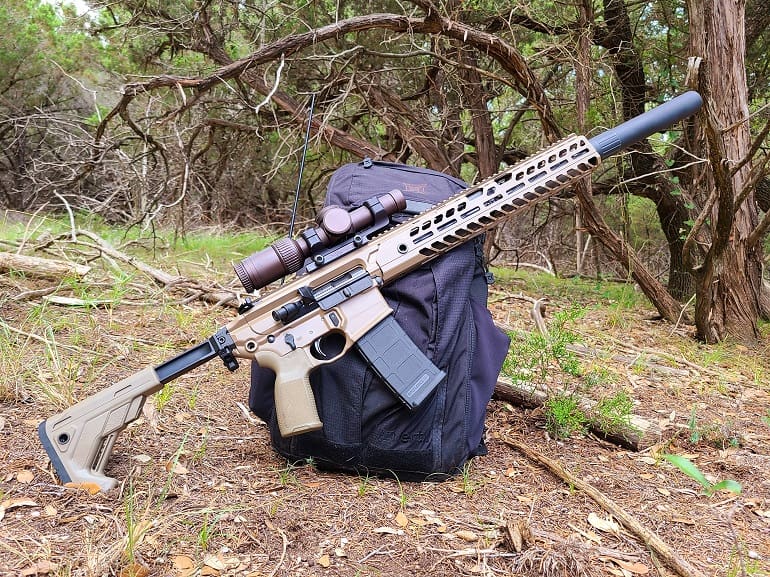
The SIG Sauer MCX Virtus Patrol rifle. Seven thousand rounds. Eleven months. Modular. Minute of angle groups. Not an AR-15.
But we’re getting ahead of ourselves.
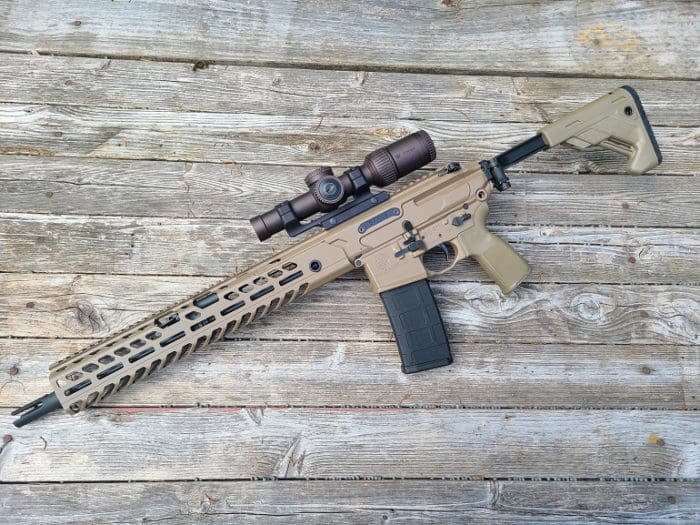
The evolutionary divergence of SIG’s flagship semi-auto carbine goes back 60 years, to innovation that originated from one of the greatest missed opportunities in the history of the firearms industry. Armalite, a Division of Fairchild Engine and Airplane Corporation, had developed the AR-10 as a potential replacement for the M1 Garand. At the same time the Army was considering replacing the M1 Garand with the AR-10, it was also reconsidering the entire way ground combat was fought, seeking the increased “firepower” of more rounds carried and fired downrange.
Armalite licensed the rights to the AR-15, a smaller caliber version of the AR-10, to Colt. That was 1959. Most of the military, including the Army, chose to go with the M14 over the AR-10 or Armalite’s other offering, the AR-16. But what really caught the eye of the US and militaries around the world was the AR-15 and its 5.56x45mm cartridge. Armalite had bet wrong.
Having lost what was to be a series of contracts that would eventually total the largest small arms purchase in our nation’s history, Armalite looked to get back in the game. By 1965, they had developed a short-stroke piston carbine in 5.56x45mm and began testing the new rifle, labelled the AR-18. Just a couple of years later, Howa Machinery Ltd. in Japan was producing and exporting the AR-18 and the semi-auto civilian version, the AR-180.

This new piston driven AR included a side charging handle and a folding stock. It also incorporated a flat(er) top for easier mounting of optics. A few versions of the AR-18 were fitted with Sionics MAW-A1 suppressors and Redfield 3-9X optics during the Vietnam war. If you thought the suppressed side charging AR with a folding stock and LPVO were new, you’re about half a century late to the party.
Alas, the US Army had already married itself to the Colt-licensed AR-15, and it would remain dominant to this day. By 1971 the production of Armalite’s short-stroke folding stock AR was halted. The AR-18 was gone.
But not forgotten.
Some specialized units around the world regularly shot their patrol carbines with suppressors attached, and also needed their rifles to work no matter what, something they were still skeptical of with the AR-15 platform. The long stroke, large piston of the AK47 had proven ultra-reliable, and many manufacturers recognized the value of keeping gas and carbon out of the action.
Manufacturers took another look at the short-stroke piston system for the AR pattern rifle. American Special Operations units would famously adopt two different versions of these systems, the HK416 and the FN SCAR, with the SCAR being much closer to the AR-18 than the HK.
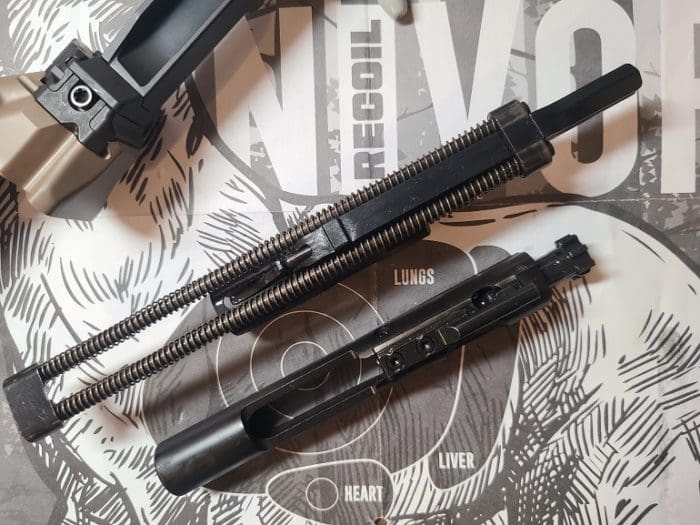
Of course, there are drawbacks to the short-stroke piston system. It’s more complex than the direct impingement model of the traditional AR-15. One has to decide if the increased reliability potential of a piston system outweighs the concern of a system with more parts to break.
You also have to wonder if there’s really an issue in the first place with either system. They both will go many thousands of rounds fired without issue. Anyone who tells you a traditional direct impingement AR-15 isn’t reliable has poor information, poor judgement, or both.
When SIG Sauer decided to develop a premium, select fire and semi-automatic carbine to shoot reliably and accurately in all conditions, they looked back to the now very well proven short-stroke piston design we saw in the AR-18 concept. They called it the MCX.
As it continued to develop, they labeled the newest version of the full 16″ barreled folding collapsible stock carbine the MCX Virtus Patrol.

The SIG MCX takes full advantage of the AR-18 short-stroke concept, although the set-up is a bit different than previous attempts by other manufacturers. SIG employs dual captured recoil return springs on top of a pivot attached to a short bolt carrier group (BCG).
This allows for a very short total length of the mechanism and doesn’t require any of it to protrude into the back of the lower at all. In fact, it leaves the lower with quite a bit of metal behind the trigger, at least as compared to a traditional AR.
Although the action mechanisms are a little more complex than a direct impingement AR-15, they don’t require any tools to disassemble and it is fairly straightforward. As there is relatively little gas and debris going back into the action, I’m not concerned about the BCG or the springs binding up on anything.
The small springs with their capped ends do present a point of failure, although being stuck right there surrounded by the metal of the upper means they don’t have too many places to go if something goes wrong.

The SIG MCX line works similarly to other short-stroke piston guns, but this one has an adjustable gas valve. In operation, it couldn’t be simpler. The rifle should come in the default position, which leaves the left side of the lever, when viewed from the muzzle, down. This is the standard position for all 5.56X45/.223 operation, with or without a suppressor.
The only time you should have to use the gas valve in the right side down position is, as the manual says, “adverse conditions” or “low function ammunition.” This position simply allows more gas back to increase the speed of travel to the bolt carrier group. The manual then fully describes what “adverse conditions” are, and how to lubricate and care for the firearm in these conditions.
Since the entirety of the action and internal recoil system lie within the receiver, there’s no need for a buffer or the associated buffer tube. SIG then put a Mil-STD 1913 rail as an integral part of the lower receiver. That opens up the opportunity to attach a wide array of stocks and pistol braces. SIG offers several types on their website.
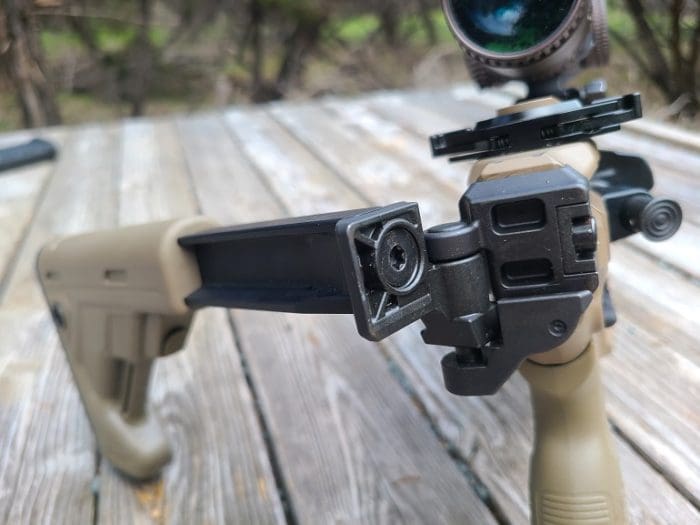
The Virtus ships with SIG Sauer’s five-position collapsible folding stock. It looks fairly minimalist, but includes quite a few features tucked into a small space. The release is a kind of button-in-a-button that’s fairly easy to use, but stays out of the way and is very unlikely to be inadvertently activated.
For sling attachments, there’s an integral quick detach cup, as well as a slanted slot at the base to feed a sling web through. The rear of the stock includes a grippy, well textured rubberized butt pad that serves to lock into clothing or web gear very well.
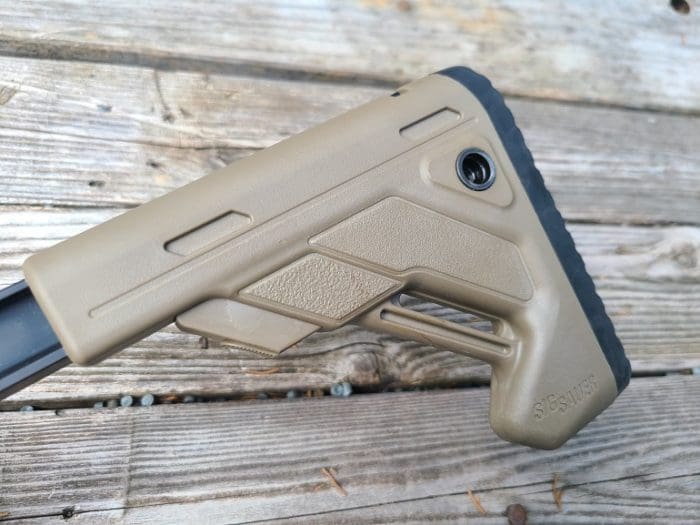
Not only does the stock have a quick detach cup installed, but so do both the lower receiver and the handguard itself. Considering there are 270 degrees of M-Lok attachment slots on the handguard as well, there’s no shortage of places to mount your sling the way you like.
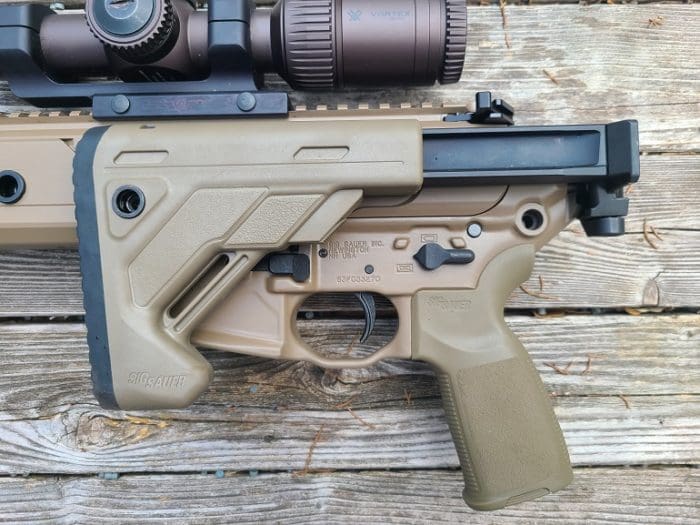
The only thing missing from the standard telescopic folding stock is a comb-height adjustment. As it stands, it’s almost just right for me, but needs a tiny bit of rise to be perfect.
In July of 2019, TTAG assigned me the Virtus Patrol review. Slick advertisement from SIG promised extreme reliability and modularity. I’ve spent the last 11 months trying to prove them wrong. I did not succeed.
I don’t know what my full round count is with this gun, but I do know it’s over 7000 now, with 3,000 of those suppressed. I shot the first 500 rounds just like I do every review. I pulled the gun out of the box, liberally sprayed CLP into it, and shot the heck out of it. I then detail stripped, cleaned, and lubed it again. I did not disassemble, clean or lube it again for another 3,000 rounds over about six months.
In March, after not shooting it for a while, I took it out, didn’t clean the rifle, but sprayed some more CLP in it, and started shooting it again. I also used the Virtus Patrol for two different optics reviews this spring. To cap it all off, using Surefire 60-round magazines and E-Lander 40-round magazines and a shooting partner, we shot a little over 300 rounds of random loosies as fast as we could. That was almost continuous fire.
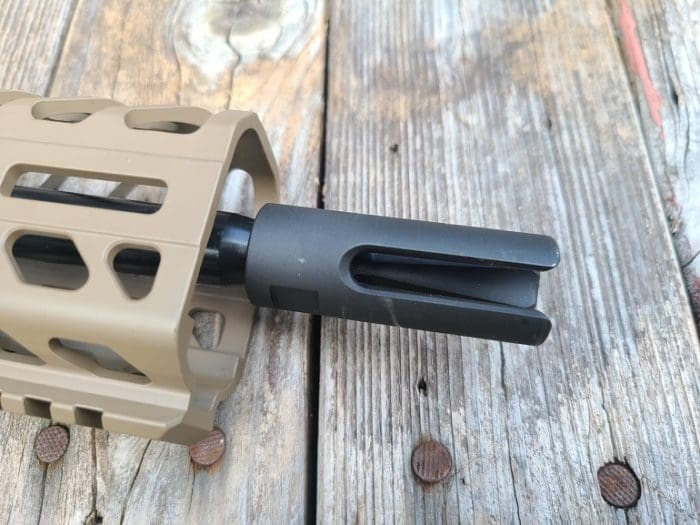
For this review, I shot IMI’s M193 55gr FMJ, a bunch of 62gr green tip of unknown origin, IMI’s 77gr OTM, Winchester 64 grain Power Point, Wolf 55gr FMJ, and Sinterfire’s 45 gain Reduced Hazard Frangible Ammunition along with whatever was laying round in the bottom of a few ammo cans.
For the entirety of firing, I kept the piston system set to the left down (from the muzzle) standard operating position. The Virtus Patrol never failed to load, fire, eject and load another round with any round at all at any time. It never stopped or jammed. I never had to use the forward assist to get a round to chamber correctly. The Virtus ran. And ran. And ran.
After that last 300-ish-round burnout was done, I went back and shot some new boxes of the Sinterfire ammunition again. This round, after all of this shooting, occasionally failed to lock back the bolt on an empty magazine. This did not ever occur if I had a suppressor mounted, or with any other round.
Yes, I did use this light ammunition unsuppressed at the end again specifically to try to make the gun fail. Long-time readers of my reviews will recognize this round, and this same issue. Semi-autos usually fail when I use this light round at the end of a long review.
The Virtus never failed to load, fire, or eject, it simply failed to lock back on an empty magazine. What’s different with the Virtus than with most semi-auto rifles is that I could then simply switch the gas piston lever to the right side down position, which immediately solved the problem and resulted in the lightweight round still locking back on an empty magazine.
I shouldn’t be surprised. After all, on page 48 of the Virtus manual, it specifically states that frangible ammunition like the Sinterfire round I used should be used with the right side down.
I should note that, since I’ve had the gun for 11 months, its been shot in every condition Texas has to offer. Also, in the course of some optics reviews, I froze the gun in a deep freeze and then immediately went out and shot it in 90 degree weather. Zero issues. I’ve submerged the gun completely in water for hours, poured out the water and shot it. No issues. I’ve buried it in a cedar mulch pile over the course of a weekend. Shook it out and shot it. No issues.
If I had any concerns about the long-term reliability of the dual captured recoil spring system, well I don’t anymore.
There are so many small details that SIG got right with the Virtus.
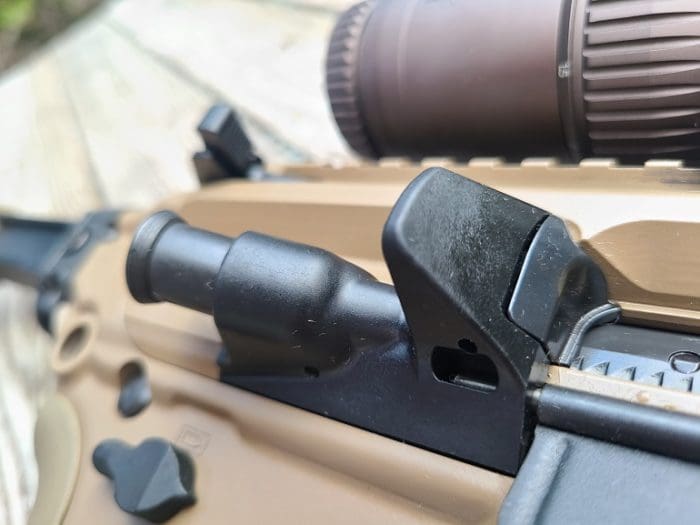
Note the brass deflector above. This photo was taken after all firing was complete. It has not been repainted or refinished. Did the finish simply not wear off? Nope, it’s some kind of hard plastic, there’s no finish to rub off. It’s hard enough that it’s very unlikely to break, and if, for some reason it does, SIG sells the entire assembly on their website for $49.
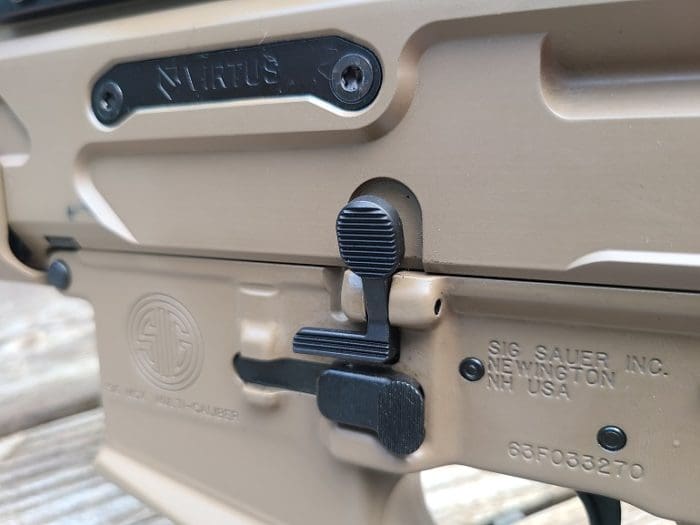
The Virtus is mostly ambidextrous, with both the safety and the magazine release available on both sides of the lower receiver. Both the magazine releases are heavily textured and easy to reach.
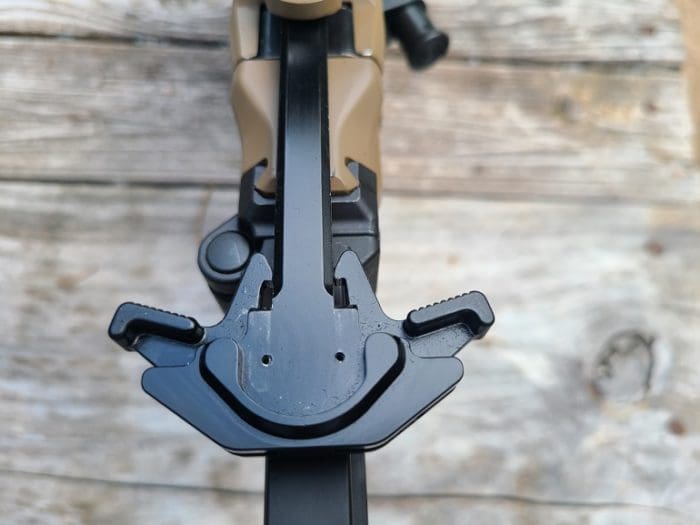
You’ll also find the enlarged charging handle can be engaged from either side as well. The charging handle internals are a little different than a standard AR’s, so it’s one of the parts that’s not interchangeable.
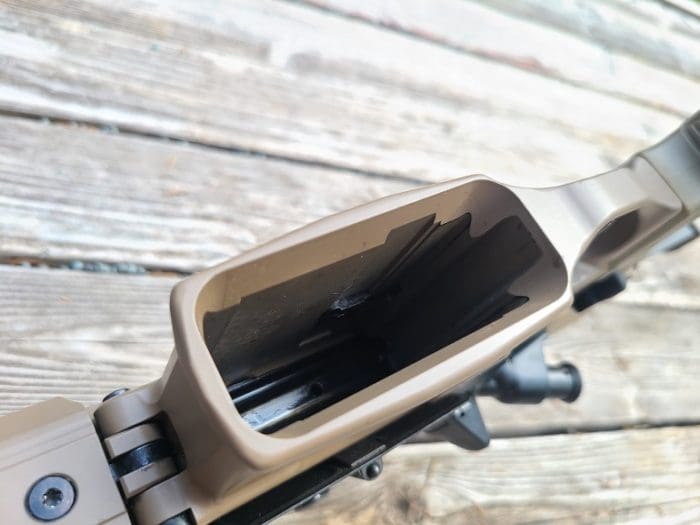
The magazine well itself is flared and beveled. Blind insertion of a magazine couldn’t be much easier, and I never had an issue with any magazine, both polymer and metal alike.
With the piston system sitting on top of the barrel, the handguard has to be pretty large. SIG Sauer chose to elongate the handguard instead of having what would have been an extremely large circular tube. People with smaller hands may need to resort to shooting with a vertical foregrip or angled grip to control the muzzle, but it’s ideal for those of us with size large hands exactly as it is.

Reaching fully forward with my support hand well in front of the piston adjustment lever, a C-clamp style grip locks the Virtus right back into my shoulder. Without any additional grip surfaces, the stock Virtus handguard is ideal. Not only do I get great control of the weapon, but the wide and airy space around the barrel ensures that gas gets ejected without burning up my hand, and that the barrel cools as quickly as possible.
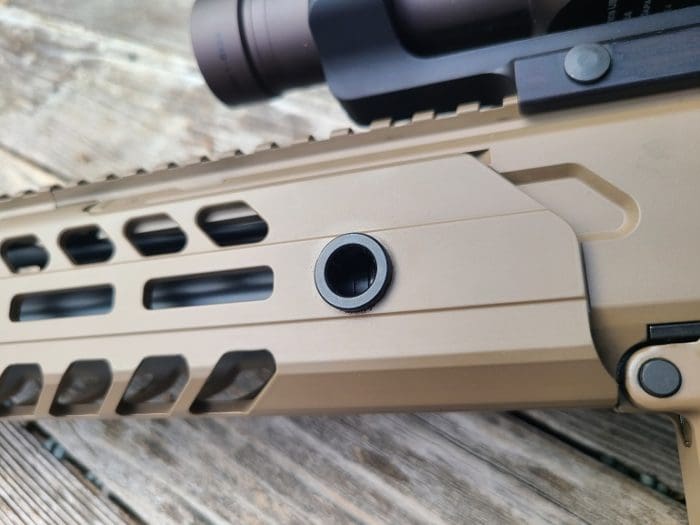
There is 11 inches of rail space on top of the Virtus Patrol. The portion of the rail that separates from the upper receiver is far forward of the front edge of the lower receiver and provides tons of mounting space for a variety of optics. That means that cantilever mounts aren’t necessary and shooters can go with stronger traditional two-piece rings.
That said, as this is a heavier gun shooting a lightweight round, I don’t foresee the diving board wobble of some cantilever mounts being a problem, and the quick detach feature of most of them is often welcome. For folks who want to mount NV optics in-line with the scope, the additional rail space makes mounting a bit simpler as well.
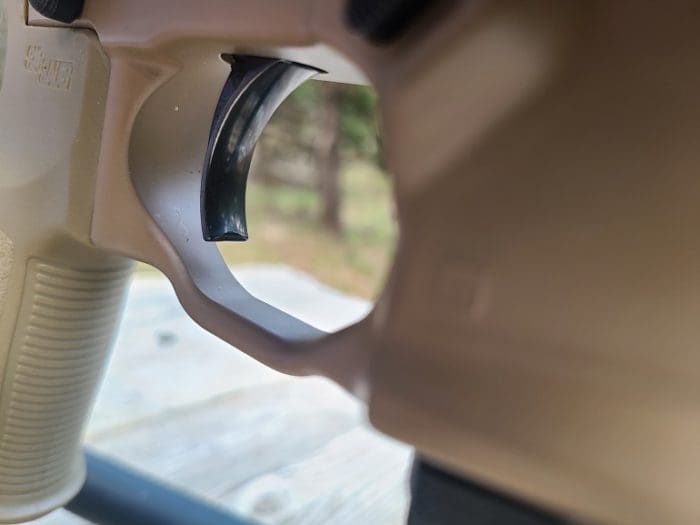
SIG Sauer calls its stock trigger on the Virtus Patrol their Matchlite Duo trigger. The trigger is often the first part replaced by many AR owners. If you are going from a stock Colt or otherwise Mil-STD trigger on an AR, I would highly recommend an upgrade to something like a LaRue or Geissele.
In the case of the Virtus, no such upgrade is necessary. Oh sure, you can buy one if you want. It will drop right in, but you won’t get much of an improvement. SIG advertises this trigger at “approximately 5 lbs.” but mine broke at a very consistent 4 lbs 3 oz. It felt lighter than that.
SIG’s two-stage trigger has no discernible grit or creep prior to the wall, which then releases with only the tiniest amount of squish. I shot this trigger back-to-back with a couple of my Geissele triggers and couldn’t make up my mind which was best. Note the shoe is curved and highly polished.
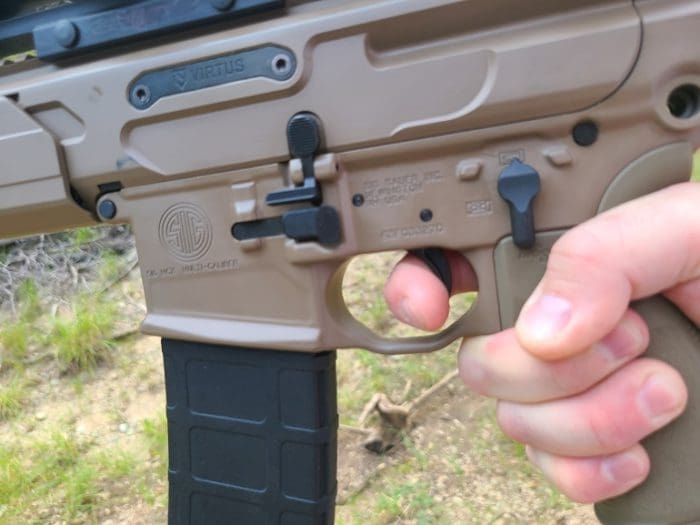
The grip on the Virtus is similar to the Magpul in that it’s also a textured firm polymer with a storage compartment in the bottom. But if you look closely, you’ll see the SIG’s grip is angled more vertically and essentially is more straight up and down than either the Magpul or standard Colt GI style. It also has a bit more of a curve to the back of the grip, like a Beretta 92’s backstrap.
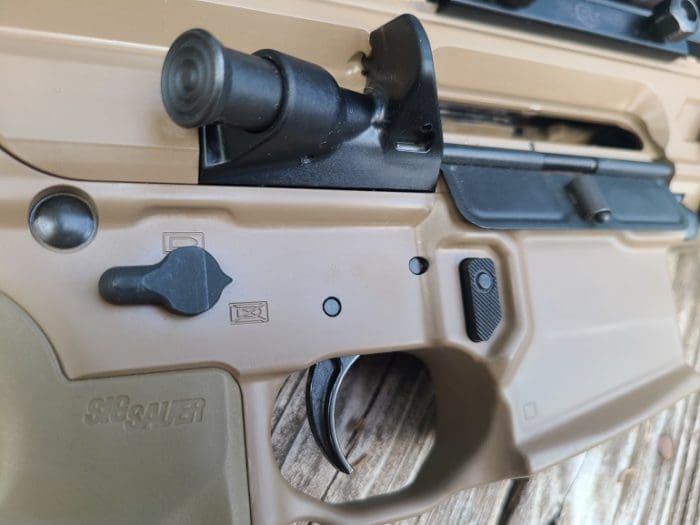
The trigger guard itself also has some interesting geometry. The very bottom of the trigger guard has been pushed down. This, in combination with the SIG pistol grip, allows for a very high grip on the gun, while also providing a large space inside the trigger well.
SIG was clearly thinking of shooters with gloves who may be asked to patrol with the Virtus Patrol. It’s enough space that even a shooter with cold weather gloves on could still fit inside the trigger well without making solid contact on the trigger itself.
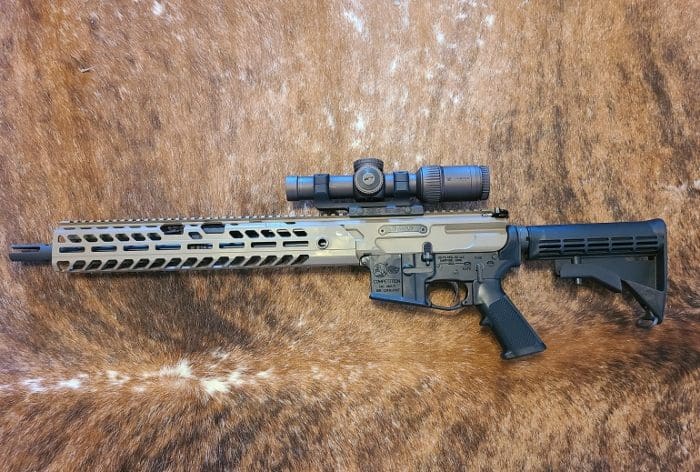
If you like the features of the upper but not the lower, you can simply purchase the upper receiver itself and it will bolt right on to any Mil-STD lower receiver.
The first thing you’ll notice when you pick up the Virtus Patrol is the weight and balance. At an advertised 7.9 lbs. naked (7.6 on my home scale), the Virtus is a full pound heavier than a 16″ barreled Colt AR-15. With a Vortex Razor 1-6X optic and a full magazine, as it was equipped for most of this review, the rifle and optic combo now weighs 10.6lbs. Throw on a light, an IR laser aiming device, or a bipod, and you’re going to get to a 12 lb. patrol rifle in 5.56 pretty fast.
We can look at that a couple of different ways. First, it’s a pound difference, and extra weight tires you out extra fast. That’s true no matter how tough you are or how good a shape you’re in.
But it’s only a pound. My combat load in the Army was anywhere from 45 lbs. at the lightest to 95 lbs. at the heaviest, if I was taking my full aide bag. One pound wasn’t going to be noticeable on a rifle slung up and attached to my armor.
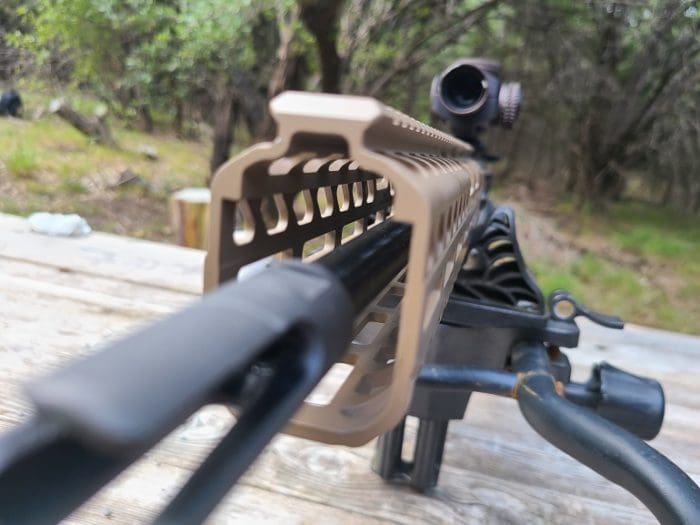
My preference is almost always for a heavier gun, depending on where the balance point is. And that’s the big difference with the Virtus Patrol. Although it’s only a pound heavier than a Colt AR-15, the SIG feels heavier than that when you pick it up.
The lack of a buffer tube and the buffer assembly, plus the added weight of the adjustable pistol system, brings the weight of the SIG farther forward than most AR pattern rifles. The balance point of the empty rifle is about an inch in front of the pivot pin. Even then, I would have guessed it was farther forward than that, considering how front-heavy it feels.
As with most things, there are advantages and disadvantages to a front heavy rifle.
There’s one significant advantage of a lighter rifle, or at least one with a balance point farther back on the gun. That is, the muzzle starts moving, and more importantly stops moving, faster. If your priority is the ability to snap up and shoot one round as fast as possible, go with a lighter front end. I’ve been able to measure it with a shot timer, and there’s no doubt that I’m faster on target when the balance of a rifle is to the rear. Advantage: lighter front.
But the whole “one shot: one kill” thing never really worked out for me in combat for a few reasons. With such a small round like the 5.56 NATO, instant incapacitation is unlikely. I also find that when people are shooting at me, my marksmanship tends to diminish significantly. Plus, more rounds = more fun. And finally, it’s not inclusive, a constant consideration in this day and age. The old sniper’s rule completely leaves out our belt-fed buddies, and that’s just rude.
There’s also a disadvantage to the lighter weight front end. Your second round out gets pointed at the target slower than if you have a heavier front end, as the barrel moves farther away from the target in recoil and takes longer to get back on. This disadvantage increases the smaller the apparent target gets. Advantage: heavier front.
The heavier front end is also easier to keep on target for precision shots off a bipod, bags, or any supported position. Ultimately, it’s about the user preference and priorities.
The Virtus Patrol comes standard with a 16″ barrel that includes the SIG tapered shoulder. The entire point of the tapered shoulder is for use with SIG’s line of suppressors. I haven’t tried their SRD556 suppressor yet, and replaced the included 3-Prong flash hider with an old AAC adapter and silencer for the review.
The cold hammer forged barrel sports a welcome 1:7″ twist rate. As the 75 and 77 grain 5.56mm rounds have gained popularity, the faster twist rates on these guns have become a necessity. I’ve long complained about the terminal ballistic performance of M193 and M855, but the Mk262 and similar rounds went a long way to making the 5.56 NATO great again.
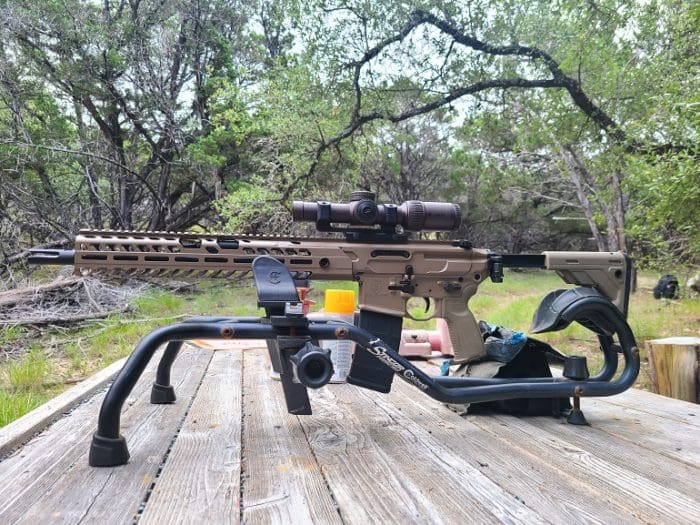
The Virtus does an admiral job of launching those heavier pills with precision. Shooting what has become my go-to ammunition, the IMI 77gr Razor Core, the Virtus prints consistent 1″ average group at 100 yards. This was the best-shooting commercially available round, although nothing else shot very far from it.
The worst-shooting round was Winchester’s 64gr Power Point hunting round, which shot 1.4″ groups. Black Hills 75gr hollow point ammunition, IMI and Federal’s 55gr FMJ, and IMI’s M855 all shot between those two extremes. All groups listed are the average of 5 shots over 4-shot strings while mounted with an Atibal Apex scope set on 14X magnification and shot from a Caldwell Stinger Shooting rest with bags.
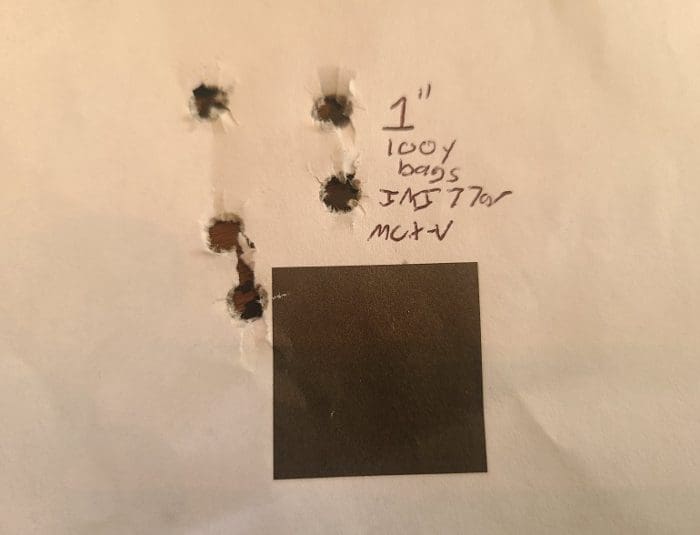
The felt recoil impulse of the Virtus Patrol is decidedly different than the traditional AR-15. In this case, different is better, although it’s a fairly low bar to clear. Gone is the “SPROINGGGG!” of the buffer and spring. It’s replaced with, well, not much at all. The Virtus has little recoil to start with, but the dual captured recoil springs, combined with the push of the piston, means a very easy cycle with no slap against the face of the shooter.
Shooting the Virtus suppressed is also roughly 400 billion times better than a traditional direct impingement AR-15. As little of the gas goes back into the action, even less of it goes back into the face of the shooter. I don’t like shooting traditional AR-15s suppressed for a couple of reasons. One is because I hate how hard it is to clean the gun afterward, but mostly it’s because I hate getting covered in gas, lubricant, and whatever else the gun is throwing back in my face.
Neither is an issue with the Virtus Patrol. A small fraction of the gas is now coming back at your face, allowing you to keep your eyes free of lubricant and debris and on your target. It’s also not pouring heat into the support hand, as that large volume of air between the barrel and gas block and the hand guard allows the gas to cool and move away prior to hitting the shooter’s palm.
Currently, there are only two caliber options available for any of the carbine-based receiver models, 5.56 NATO and .300 BLK. I remember when the MCX line originally came out, it was intended that there be a 7.62x39mm version, but that seems to have just been all talk.
The version I’d like to see — and maybe I’m the only one because it doesn’t exist on the SIG website — is a true DMR version. That would simply be the same gun as the Virtus Patrol but with a 20″ barrel and a stock with an adjustable comb height and length of pull. A .300 Hamr barrel would be awesome too, as it would make the Virtus a true “do-it-all” rifle, as it’s all you’d need to hunt most game in North America.
As it is, the SIG Sauer Virtus is certainly the most complete and flexible carbine line on the market. You can purchase small parts, user-changeable barrel assemblies, sights, caliber conversions, stocks, grips, triggers, M-LOK handguards, and more directly from SIG’s website.
SIG fully committed to a varied line, and provides multiple barrel lengths in both calibers, as well as multiple hand guards and stocks. With these features, there really are hundreds of combinations the Virtus is capable of. In addition to that, you can put the Virtus upper on any Mil-STD lower, increasing the possibilities even more.
There are, however, some legal challenges with how far you can go. Once a rifle is a rifle, it can’t become a pistol. It can legally become a short barreled rifle, but only with the permission of our federal overlords. Also, be aware that “constructive intent” is a thing. I’ll cover all that in a subsequent article, as I’ll be converting this Virtus to short barreled rifle and run it in .300 Blackout. I’ll do a full review on that version as well.
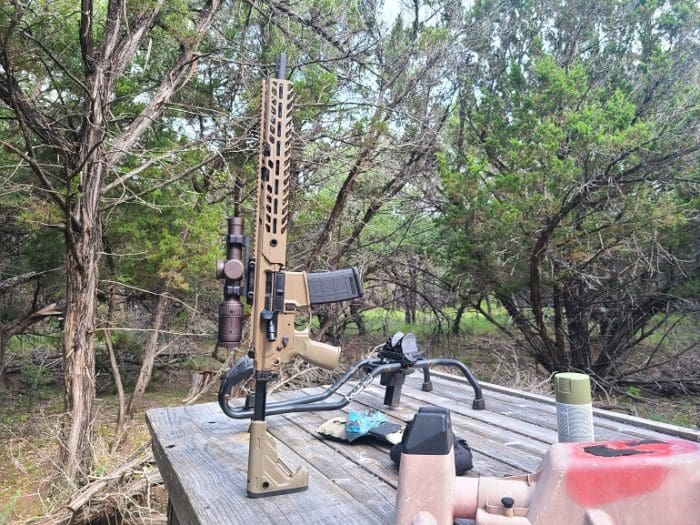
The SIG Sauer MCX Virtus Patrol rifle lives up to the hype. Their claims of great reliability and modularity turned out to be a rare example of truth in advertising. Not only is it today’s apex of the AR-18’s short-stroke piston system development, it’s also well thought-out, with tons of the little details exactly as they should be. As usual, SIG is pretty proud of their premier carbine, but this one may very well be worth it.
Specifications: SIG Sauer MCX Virtus Patrol
CALIBER: 5.56 NATO
BARREL LENGTH: 16 in
MAGS INCLUDED: (1) 30rd Polymer AR-15 Magazine
ACTION TYPE: Semi-Auto
STOCK TYPE: 5-Position Telescoping Folding
BARREL MATERIAL: Cold Hammer Forged Carbon Steel
TRIGGER TYPE: Matchlite Duo Trigger
TWIST RATE: 1:7
FOREND TYPE: Alloy
GRIP TYPE: Polymer
RECEIVER FINISH: FDE
OVERALL LENGTH: 35.5 in
OVERALL WIDTH: 2.8 in
HEIGHT: 8 in.
THREADS: 1/2 in – 28 tpi
ACCESSORY RAIL: M-LOK
OPERATING SYSTEM: Gas Piston
WEIGHT 7.9 lbs.
PRICE: Found online on several retailers between $1,700 and $2,000
Ratings (out of five stars):
Style and Appearance * * * *
It’s an AR, so there’s only so much style it can have in the first place. As it is, the lines of the receivers, stock, and grip, all flow well. SIG has clearly paid attention to those details throughout the gun and taken them not as parts alone, but parts of a whole. The finish is smooth and even throughout.
Customization * * * * *
The most modular, customizable AR on the market. Extra points given to the fact that SIG offers so many options direct from the factory website.
Accuracy * * * *
It didn’t break 1 MOA with any commercial round tried, but it danced all around there with multiple rounds.
Reliability * * * * *
Supreme.
Overall * * * * 9/10ths
I can’t give the Virtus Patrol a full 5 stars since it didn’t break 1 MOA. Yes, I”m being really picky here. The rifle is very accurate, and incredibly reliable. The phenomenal modularity of the platform, all supported direct from the manufacturer, puts this gun far ahead of the competition. SIG has made a heck of a gun.
[buy_now link=https://amzn.to/3fKLLKM]

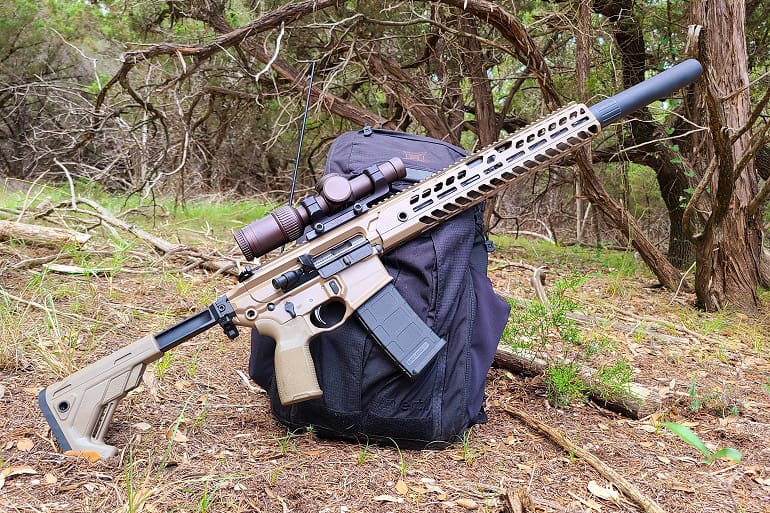



Stellar review! Saw a review on YouTube for this. Similarly postive. I’d give it 5stars…
“I froze the gun in a deep freeze and then immediately went out and shot it in 90 degree weather. . . . I’ve submerged the gun completely in water for hours, poured out the water and shot it. . . . I’ve buried it in a cedar mulch pile over the course of a weekend.”
Remind me to never lend you a gun.
Ralph, never lend me a gun.
psycho
Huh….everybody is reviewing the the Sig Virtus guns right right now. Smells…shillericous !!!
Are you insinuating he’s not being honest about the gun? Did you read the review? Did he misrepresent some (any) aspect of the rifle?
It hard to belive any level of enthusiasm for any new overpriced ar.
In all fairness, the number of reviews for a new firearm is not necessarily related to the veracity of any individual review.
Often, it’s simply due to the fact that nothing resembling the firearm has ever hit the market before, or if it has, at such an attractive price point.
But you must admit that the level of enthusiasm can also be affected by the aggressiveness of a marketing group in soliciting reviews. That’s not your fault. You’re a review site, and it’s your job to post reviews, no matter how many other folks are posting similar reviews.
By the way, I think there is a typo on the first line. Did Jon mean to say “rifle” instead of “fivld”?
Except it’s a false premise from the start. This is not a new gun. It’s been on the market for years. TTAG is probably the very last major site to review it, as usual.
Madcapp’s comment is just shit posting, and you’ve gone along with it.
I meant no disrespect, Godfather. I had never heard of the Virtus before, but I’m not a Sig sort of guy. I see now that it was introduced in 2018. I stand corrected.
What I was trying to say, in typically overly verbose and roundabout fashion, was that just because lots of folks are reviewing something popular does not make them shills. (At least not until they deliberately lie, which you haven’t done).
But also I know from my own experience that Sales and Marketing Departments Never Rest, and they don’t exactly complain about the number of positive reviews they get.
Bullshit. This guns been on the market for years now, and TTAG got it long after everyone else reviewed it. And then I shot it for almost a year before publishing it. Who else has a new review of the Virtus out?
I liked the approach to this review. Too many reviews are based on the first weekend of ownership.
Nicely done.
That is especially true of Amazon. There’s often lots of “review updates” where folks go back and say “Loved it til it stopped working”. So I just cruise straight to the one-star reviews for the straight skinny.
I work security for a nuke plant and this is the rifle we carry, except that ours are black. They’re pretty good, we do drills with them and I’d say they’re better than an average AR by a few degrees.
They DO have one annoying quirk that our armorer’s discovered. You HAVE to make sure the firing pin is seated properly in the bolt after field stripping or it won’t function. That and unless you run suppressed (we don’t) keep the gas key on “+”. It’s basically a bolt action if it isn’t.
Out of curiosity why’d you guys go with this gun for nuke plant protection vs. other offerings on the market?
Hate the huge forend, but otherwise looks ok, but more money than I tend to spend on a carbine.
Banned next January.
BLACK LIVES MATTER
One of the problems when you give trolls free reign is it becomes harder to detect sarcasm.
ONLY BLACK GANGBANGER LIVES MATTER ALL OTHERS CAN FOAD!!!
I just got a sarcastic comment moderated. I bet it would have sailed through if I was one 8fMcCrystal’s trolls. Free speech you know. Only partial sarcasm there.
If it’s banned, who will take it?
Overpriced vaporware.
Vaporware? Easily found online. First several links provided after a search have them in stock.
Not in stock anywhere that I have seen
I prefer the legacy model. Typical Sig QC, sticky ejector. I replaced the plastic spring retainer with a steel one. As mine wasn’t upgraded . The original design was fine then the lawyers got involved.
Rather have an original AR-180 aka “The Widow Maker”. Sent many a loyalist to hell.
Free the six counties!!!!
And it’s down in The Bogside, that’s where I want to be…
With my little Armalite.🤘
jwt, generally agree with you, but; “Anyone who tells you a traditional direct impingemt system has poor information, poor judgement, or both.” You are just plain wrong. I’ve said this before. I was issued an AR platform rifle from 1979 until 2106. Regardless of maintainence they all malfunctioned. Even my several personally owned ARs. None of my H&Ks, Galils, M-1 rifles, Beretta BM-62, FN-FALs ever malfunctioned. Not once. Even the ones I fired in the military. I had to do a little cross arms training.The Canadians loved our M-16A1. It was light. Of course, the whole thing about it not working was kind of a bummer.
You constantly talk about how unreliable the AR-15 platform is, and yet here in 2020 you seem to be the only shooter in the world who feels that way. What do you know that the rest of us don’t? I went 1500 rounds of all types in my Rock River (pre betrayal), over the course of several months, with zero cleaning and no lube. Zero failures of any kind, and I only stopped the experiment because it was getting annoying to have such a dirty rifle, not because it started jamming. I’m far from alone in my experience
Direct impingement is dirty. A Garand type piston system runs much cleaner which ultimately means better reliability. I had a Mini-14 that I never field stripped until I got ready to sell it. All I ever did was clean the barrel and chamber, and occasionally oil what I could without disassembly. Fired 5000+ rounds through it. The internals were cleaner than my AR after 1000 rounds
The direct impingement system is dirtier, and it still doesn’t matter. They run and run and run. I’ve seen a sons of liberty gun works AR go 17 thousand rounds without any maintenance other than lube.
Thousands of rounds down range without issue is the standard for most ARs now.
Red, let me explain. I’m not lying. I want to like ARs. They’re inexpensive, they are way more accurate than they should be. And they’re ergonomics are second to none. But they are not relible. A friend and I bought an ass load of Galil battlefield pick-up mags. As is. We took them to the range. Works this box. Doesn’t, that box. We were shooting semi and full auto Galils. At the end of the day one Galil had a live round in the lower receiver. It had been beaten apart between the rim and the shoulder. The 55 grain FMJ bullet was rattling around in the lower also. Never a malfunction. Drop a live round in the lower of an an AR. See how long it works. Carry an AR if you want to. It’s your life.
“You constantly talk about how unreliable the AR-15 platform is, and yet here in 2020 you seem to be the only shooter in the world who feels that way.”
He truly is the only one that feels that way. For real. Statistically speaking he is at least 9 standard deviations away from the mean. The mean being the opinion that the AR15 is a reliable platform.
those opinions will shift when the “live round bouncing around inside the receiver” test protocals are finally released. it’s the new torture.
No, I’m not the only one who feels that way. Mike has three ARs. A Colt Delta H-Bar, an FN and a HK. He’ll tell you none of them are half the rifle his 91 is. Randy owns several His. All Volmer conversions. 9mm to 7.62 NATO. Even one in 7.62X39. And one “nice” AR he took in trade. I saw it and asked “WTF?” He said someone would want it one day and he’d make some money. Mark H. has a couple of ARs “just because.” He also said they would be the last thing he would take out of the safe if the SHTF. Mark D. won’t own an AR. Strictly HK&AK. Noel just laughs when someone asks why he doesn’t like ARs. I could name another fifty people with similar stories, but you get the point.
“…a traditional direct impingement system has poor information…”
thinkin’ you forgot the isn’t reliable part.
I know, but your experience is dramatically different than millions of others.
The AR-15 platform is, at this point, more widely distributed and tested in real world use than any other carbine on Earth, with maybe the exception of the AK platform. Maybe.
Hundreds of thousands of service members have carried it in combat over the last 20 years alone, and surveys show that they report very few malfunctions in combat and a lot of confidence in their weapon.
Your experience is the outlier.
I have had Galils fail, I have had G3 fail, I have had FALs fail, I have had ARs fail. All machines fail.
Meh. I won’t buy a weapon from a company that builds a combat handgun that fires itself if you nudge the slide wrong. Sounds like this in particular is a solid rifle, and yet I can’t trust Sig. how long has it been since they released a new firearm that DIDNT have a recall?
Red, I don’t know what you’re talking about. I don’t think you do either. A Galil built in the eighties has what to do with a handgun built by a completely different company now, how? Besides let’s compare the AR platform to a G-3, L1-A1, AK-47, etc… I’ll wager I have more trigger time on an AR rifle than you have standing on your hind feet and breathing free air.
it’s always hard to figger if your bragging or complaining, besides the fact that you and red are having two different convo’s.
check out some mouth puke torture tests. modern di guns run and run and run. your experience should be most meaningful to you, but you shouldn’t deny yourself the benefit of other’s uses. it’s a design; you had gov issued equipt. and that was then.
a larue or war sport is as reliable as anything that you own. except your russel knives. which have crappy steel.
i still don’t want an ar. .223 is a little femmy and all the variations are compromises. but i’ll build one so i know them.
tsbhoa, are you drunk tonight, or is your spell check seriously fucked up? I’ve been on the line with just about every AR you care to name. Owned a few. Everything from Colt SP-1 to Wilson. They’re all just ARs. Nothing special. Oh, it’s spelled “R A N D A L L.” Don’t want to spend $500 +/- for a knife? Don’t. The waiting list for a Randall isn’t five years long because they suck. You’ll just be one more hump out of the way.
so ar’s are ar’s. it is what it is. brilliant.
i could have another randall on it’s way tomorrow.
https://knifesteelnerds.com/2019/08/26/o1-steel-history-properties-and-how-to-heat-treat/
learn something about randall utilizing uddeholm steel when it was first manufactured here. and take special note of it being at the bottom of every graph in the article.
because: it’s really really cheap, easy to forge and takes a beautiful finish.
https://www.youtube.com/watch?v=lOjdy0K3X7s
marty feldman r.i.p.
t, I can have a Randall on the way tomorrow also. At a considerable premium. The knives you see on eBay and the forums sell for hundreds over catalog price. I usually don’t wait the five year thing. I just call Chris Stanaback. A friend. I get bumped up. Should have my new tricked out #1 in about six months. What blade did you say you carry?
I wonder how SIG MCX compares to Brownell’s BRN 180?
Virtus works better. 180 is cooler.
if you put the upper on a MIL-STD AR15 lower, is there a way to attach the folding stock?
Yes. Sig (and I believe others) sell vertical pic rail adapters for standard AR lowers. In fact, IIRC, at some point I think Sig was packaging some of the later gen 1 MCX Patrol rifles this way (std AR lower w/ rear pic adapter), probably clearing out inventory before the Virtus versions were released. Anyways, Sig’s adapter is a bit expensive but the lines flow better and it has a QD cup on the bottom. Search for “MCX stock adapter kit.”
If only it was in .308
Just go with a POF Revolution.
This will be my next rifle purchase.
Short stroke, 7.62×51 piston gun FTW.
Now that’s a firearm review!
Having recently shot a suppressed AR15, the gas blowback is real and stings the eyes pretty hard once you get speeding along.
If I were not running a suppressor, I wouldn’t bother with piston.
Inspired from the tv series Yellowstone, this Kelly Reilly Blue Coat is poncho-style outerwear. Kelly Reilly portrayed the role of Beth Dutton, daughter of John Dutton in the series.
If you love to wear action movies and games outfits so must check the top 5 superb Cosplay Jackets which gives you a killer and stunning look on this cosplay festival.
หวย อันดับ 1 มาแรงแซงทุกเว็บ
เว็บพนันออนไลน์ เว็บตรง ไม่ผ่านเอเย่นต์ฝาก-ถอน รวดเร็ว ด้วยทีมงานคุณภาพ ตลอด 24 ชั่วโมง มีความยุติธรรมและโปร่งใส ไม่เคยมีประวัติการโกงลูกค้า
“HUAYDED789 หวยออนไลน์ 24 ชั่วโมง ระบบที่ทันสมัย แทงหวยง่าย โอนเงินไว หวยออนไลน์ที่นี่จ่ายสูง ส่วนลดเยอะ โปรโมชั่นพิเศษสำหรับสมาชิกใหม่ และสิทธิพิเศษมาก มาย แจกเครดิตฟรีอย่างต่อเนื่อง”
Comments are closed.